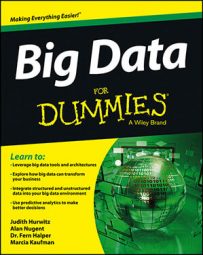Is big data really new or is it an evolution in the data management journey? It is actually both. As with other waves in data management, big data is built on top of the evolution of data management practices over the past five decades. What is new is that for the first time, the cost of computing cycles and storage has reached a tipping point. Why is this important?
Only a few years ago, organizations typically would compromise by storing snapshots or subsets of important information because the cost of storage and processing limitations prohibited them from storing everything they wanted to analyze.
In many situations, this compromise worked fine. For example, a manufacturing company might have collected machine data every two minutes to determine the health of systems. However, there could be situations where the snapshot would not contain information about a new type of defect and that might go unnoticed for months.
With big data, it is now possible to virtualize data so that it can be stored efficiently and, utilizing cloud-based storage, more cost-effectively as well. In addition, improvements in network speed and reliability have removed other physical limitations of being able to manage massive amounts of data at an acceptable pace.
Add to this the impact of changes in the price and sophistication of computer memory. With all these technology transitions, it is now possible to imagine ways that companies can leverage data that would have been inconceivable only five years ago.
But no technology transition happens in isolation; it happens when an important need exists that can be met by the availability and maturation of technology. Many of the technologies at the heart of big data, such as virtualization, parallel processing, distributed file systems, and in-memory databases, have been around for decades.
Advanced analytics have also been around for decades, although they have not always been practical. Other technologies such as Hadoop and MapReduce have been on the scene for only a few years. This combination of technology advances can now address significant business problems. Businesses want to be able to gain insights and actionable results from many different kinds of data at the right speed.
If companies can analyze petabytes of data (equivalent to 20 million four-drawer file cabinets filled with text files or 13.3 years of HDTV content) with acceptable performance to discern patterns and anomalies, businesses can begin to make sense of data in new ways. The move to big data is not just about businesses.
Science, research, and government activities have also helped to drive it forward. Just think about analyzing the human genome or dealing with all the astronomical data collected at observatories to advance our understanding of the world around us. Consider the amount of data the government collects in its antiterrorist activities as well, and you get the idea that big data is not just about business.
Different approaches to handling data exist. Data in motion would be used if a company is able to analyze the quality of its products during the manufacturing process to avoid costly errors. Data at rest would be used by a business analyst to better understand customers’ current buying patterns based on all aspects of the customer relationship, including sales, social media data, and customer service interactions.
Keep in mind that businesses are still at an early stage of leveraging huge volumes of data to gain a 360-degree view of the business and anticipate shifts and changes in customer expectations. The technologies required to get the answers the business needs are still isolated from each other.
Big data is not simply about one tool or one technology. It is about how all these technologies come together to give the right insights, at the right time, based on the right data — whether it is generated by people, machines, or the web.

